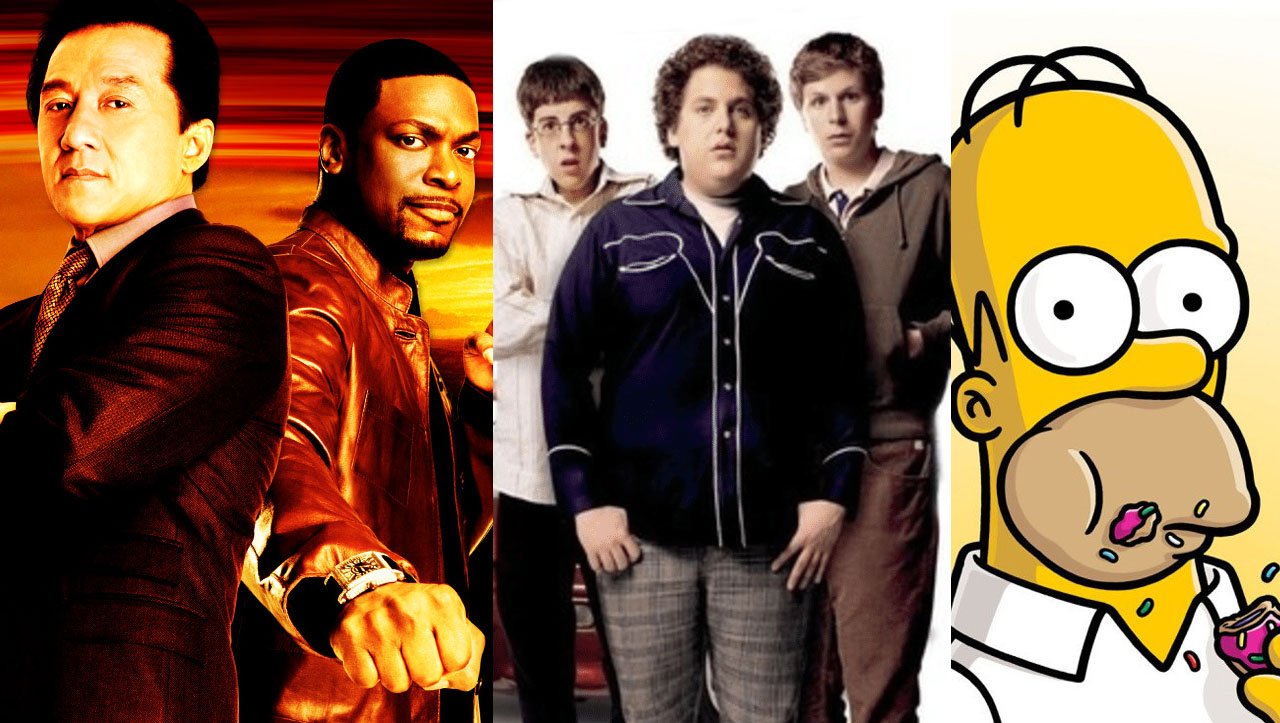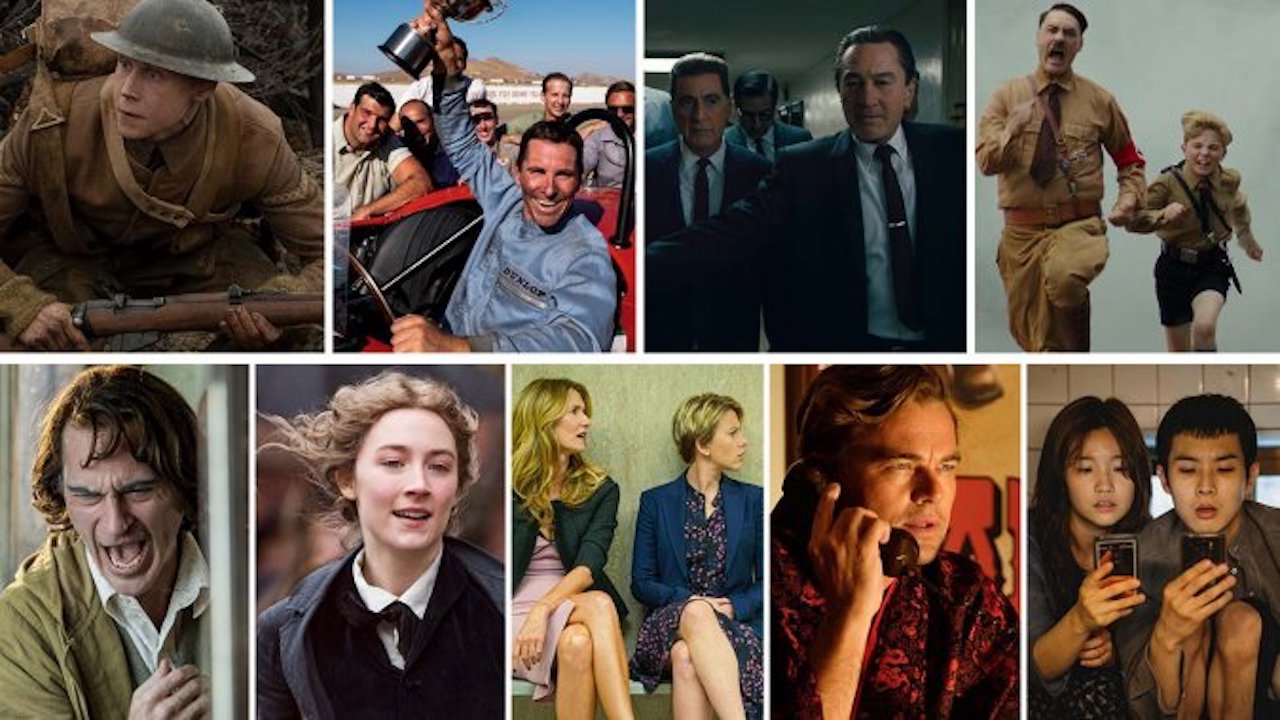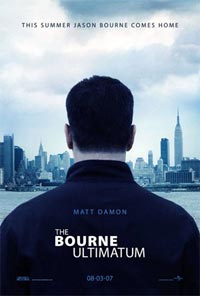 The Bourne Ultimatum (2007, Dir. Paul Greengrass):
The Bourne Ultimatum (2007, Dir. Paul Greengrass):
“Will you commit to this program?”
Jason Bourne (Matt Damon), ex-government assassin and taciturn survivalist, is asked this very question in a grainy flashback early on in The Bourne Ultimatum, and it just as easily could be an appeal to the audience: would we kindly commit to a film series with a hero just as indestructible as James Bond, but loaded with amnesia and moral regret over the beast he has become? More precisely, is this cipher-like Mr. Bourne compelling enough for us to follow him to the ends of the world, as he seeks to break the final locks on his clouded memory and discover what it was that drove him to take on the job of ultra-ultra-secret hitman?
The answer seems to be an unequivocal yes, based on the critical plaudits lavished on the third entry of the Bourne saga. In the current real-world climate, we dig spy thrillers that can inject just a smidgen of realism into the usual outlandish antics, and it doesn’t hurt if they don’t insult our intelligence outright. Thus we have The Bourne Ultimatum, a nifty piece of filmmaking that is nearly peerless in its action-reaction thriller mechanics.
Like a shark, the film survives on constant movement, one breathless chase and averted trap after another. Those who haven’t seen the first two films, The Bourne Identity and The Bourne Supremacy (directed by Doug Liman (who also serves as the guiding hand behind the series) and Paul Greengrass, respectively) will have to make do with some handy flashbacks, but story is truly secondary here; just think of Bourne as the wily mouse, and the big bad CIA, his former employer, as the giant cat threatening to sink its claws into him, and you’re ready to sit back and have your eyeballs seared by the frenetic, handheld style that is fast becoming Greengrass’s calling card. Which is not to say that Ultimatum is undisciplined or a migraine nightmare — within the constant whooshes and bobbing movements of the camera, Greengrass manages to build choreography, rhythm, and suspense, little details popping out to ground us even in the midst of giant crowds on a train platform, or amongst the mountainous rooftops of a Moroccan city.
 Happiest when our hero is in direct peril, the film’s two major action sequences are adrenaline dreams. The first is a manhunt inside London’s Waterloo Station wherein Bourne must rendezvous with nosy British reporter Simon Ross (a wasted Paddy Considine) and avoid the myriad closed-circuit cameras and agents on their tail. Armed with only two cell phones and a preternatural ability to sense danger, Bourne simultaneously avoids and gets the drop on his foes, and as he does so the sequence becomes a master class in geography, movement, and tension — there must have been an army of editors working around the clock on this one, and the results are worth it. The second bravura setpiece is a footchase amongst the alleys and rooftops of Tangier in which Bourne must catch up with a CIA bagman who is on his way to rub out Nicky (Julia Stiles), his last tangible link to his days as an amnesia-free assassin. Juxtaposing pure acrobatic thrills — Bourne pulling off his best Parkour impersonation as he leaps through windows — with the inexorable march of the hitman closing in on his prey, it culminates in a one-on-one fistfight in a bathroom that puts a similar moment in Casino Royale to shame (ironically enough, Gary Powell is the fight choreographer for both films).
Happiest when our hero is in direct peril, the film’s two major action sequences are adrenaline dreams. The first is a manhunt inside London’s Waterloo Station wherein Bourne must rendezvous with nosy British reporter Simon Ross (a wasted Paddy Considine) and avoid the myriad closed-circuit cameras and agents on their tail. Armed with only two cell phones and a preternatural ability to sense danger, Bourne simultaneously avoids and gets the drop on his foes, and as he does so the sequence becomes a master class in geography, movement, and tension — there must have been an army of editors working around the clock on this one, and the results are worth it. The second bravura setpiece is a footchase amongst the alleys and rooftops of Tangier in which Bourne must catch up with a CIA bagman who is on his way to rub out Nicky (Julia Stiles), his last tangible link to his days as an amnesia-free assassin. Juxtaposing pure acrobatic thrills — Bourne pulling off his best Parkour impersonation as he leaps through windows — with the inexorable march of the hitman closing in on his prey, it culminates in a one-on-one fistfight in a bathroom that puts a similar moment in Casino Royale to shame (ironically enough, Gary Powell is the fight choreographer for both films).
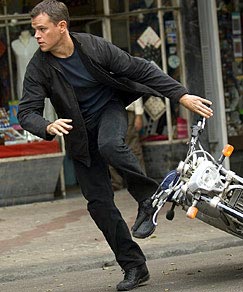 If you’re an action junkie, those two sequences alone would be worth the price of admission, but it’s a shame that one must consider the rest of the film. The Bourne movies have followed a strange inverse progression — as the filmmaking has become more accomplished with each entry, the story has become less and less interesting. Doug Liman, who directed the Bourne Identity, has nothing on Greengrass as a filmmaker, and yet the first film, which also had the advantage of introducing the mystery of Bourne, had a dog-eared soulfulness about it despite the de rigeur car chases and shootouts. What tends to linger from The Bourne Identity are the character moments — the mounting bewilderment and horror on Franka Potente’s face when she witnesses Bourne making his first kill; the resignation in the mortally wounded Clive Owen’s voice when he groans, “Look at what they make you give”; the pitbull ferocity in Chris Cooper’s CIA operator when he confronts Bourne and throws the amnesiac’s confusion right back at him. In contrast, Greengrass’s Supremacy upped the ante on the action scenes, and even though the ruckus all seemed a bit too much by the finish, at least there was a semblance of emotional payoff, as a rueful Bourne came face to face with the orphaned daughter of the Russian diplomats he assassinated. With the film’s final shot of Bourne emerging on the streets on New York City, back on his home turf so to speak, we seemed primed for an escalation of intrigue and emotional involvement.
If you’re an action junkie, those two sequences alone would be worth the price of admission, but it’s a shame that one must consider the rest of the film. The Bourne movies have followed a strange inverse progression — as the filmmaking has become more accomplished with each entry, the story has become less and less interesting. Doug Liman, who directed the Bourne Identity, has nothing on Greengrass as a filmmaker, and yet the first film, which also had the advantage of introducing the mystery of Bourne, had a dog-eared soulfulness about it despite the de rigeur car chases and shootouts. What tends to linger from The Bourne Identity are the character moments — the mounting bewilderment and horror on Franka Potente’s face when she witnesses Bourne making his first kill; the resignation in the mortally wounded Clive Owen’s voice when he groans, “Look at what they make you give”; the pitbull ferocity in Chris Cooper’s CIA operator when he confronts Bourne and throws the amnesiac’s confusion right back at him. In contrast, Greengrass’s Supremacy upped the ante on the action scenes, and even though the ruckus all seemed a bit too much by the finish, at least there was a semblance of emotional payoff, as a rueful Bourne came face to face with the orphaned daughter of the Russian diplomats he assassinated. With the film’s final shot of Bourne emerging on the streets on New York City, back on his home turf so to speak, we seemed primed for an escalation of intrigue and emotional involvement.
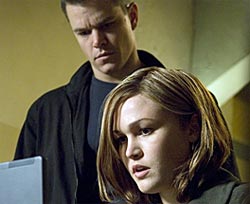 Disappointingly, Ultimatum puts our hero back in the deep freeze. Damon seemed a bit too callow as a trained assassin in Identity, but he has grown into the role, and one can read hints of regret and uncertainty within his terse silences. Too bad that screenwriter Tony Gilroy has run out of actual conflict or ambiguity to fill up those silences. Limited to maybe a couple dozen lines through the entire film, Bourne as a character has never been more dour or distant, save an unconvincing little speech in which he proclaims he sees the faces of the people he killed — in Damon’s monotonic delivery, he might as well be talking about tomorrow’s weather forecast. The only shot of humanity arrives in the form of Julia Stiles, and even though continuity is screwed with (the two apparently had an affair in the past which is not even hinted at in the previous movies), her guarded delivery of the line “It was difficult for me … with you” is the one moment in the film in which emotional disclosure is even broached.
Disappointingly, Ultimatum puts our hero back in the deep freeze. Damon seemed a bit too callow as a trained assassin in Identity, but he has grown into the role, and one can read hints of regret and uncertainty within his terse silences. Too bad that screenwriter Tony Gilroy has run out of actual conflict or ambiguity to fill up those silences. Limited to maybe a couple dozen lines through the entire film, Bourne as a character has never been more dour or distant, save an unconvincing little speech in which he proclaims he sees the faces of the people he killed — in Damon’s monotonic delivery, he might as well be talking about tomorrow’s weather forecast. The only shot of humanity arrives in the form of Julia Stiles, and even though continuity is screwed with (the two apparently had an affair in the past which is not even hinted at in the previous movies), her guarded delivery of the line “It was difficult for me … with you” is the one moment in the film in which emotional disclosure is even broached.
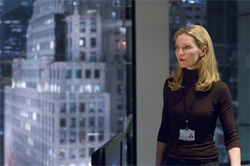 More a frazzled pinball than a human in this movie, Bourne in Ultimatum bounces from locale to locale just long enough for Greengrass to throw in a disinterested panoramic shot of the city before cutting to the next chase. Confusingly, the action begins in Europe before finally relocating to New York City, as the chronology from the preceding film gets juggled. It might have been a neat move if the filmmakers didn’t regurgitate the same “get Bourne” plot from Supremacy; alas, we are exposed to yet another conspiracy within the CIA, as “bad” honcho Noah Vosen (a sly, slick David Strathairn) tries to eliminate Bourne before the “good” honcho Pamela Landy (Joan Allen, doing what she can with a character that is essentially reduced to standing around and wringing her hands) can make contact with him and discover the ultra-ultra-secret program that converted Bourne from Army officer to black ops specialist. So once again we get to see control rooms filled with video screens, shout-downs between men in ties and shirt sleeves, and dialogue that sinks to B-movie action cliches (“I need the information, and I need it yesterday!”).
More a frazzled pinball than a human in this movie, Bourne in Ultimatum bounces from locale to locale just long enough for Greengrass to throw in a disinterested panoramic shot of the city before cutting to the next chase. Confusingly, the action begins in Europe before finally relocating to New York City, as the chronology from the preceding film gets juggled. It might have been a neat move if the filmmakers didn’t regurgitate the same “get Bourne” plot from Supremacy; alas, we are exposed to yet another conspiracy within the CIA, as “bad” honcho Noah Vosen (a sly, slick David Strathairn) tries to eliminate Bourne before the “good” honcho Pamela Landy (Joan Allen, doing what she can with a character that is essentially reduced to standing around and wringing her hands) can make contact with him and discover the ultra-ultra-secret program that converted Bourne from Army officer to black ops specialist. So once again we get to see control rooms filled with video screens, shout-downs between men in ties and shirt sleeves, and dialogue that sinks to B-movie action cliches (“I need the information, and I need it yesterday!”).
 It is curious — for all the sophistication and cutting-edge brio of the filmmaking, the plotting of Ultimatum rests on some awfully hoary devices (incriminating classified documents kept in a safe, a newspaper reporter and his Deep Throat source, a clue scrawled on a scrap of notepaper). Posing as a brainy spy thriller, Ultimatum has nothing on the classics of the genre (The Sandbaggers, John Le Carre’s George Smiley novels), which perfected the art of the mind game, spies engaging each other through espionage, counterstrategems, and gamesmanship, tension generated through smarts as well as physical audacity. Ultimatum‘s single trump card is sensual assault, and by the time the action hits New York City, the center can no longer hold, the film winding down with an anticlimactic car chase that mirrors the one in Supremacy without adding anything new, and a mushy confrontation with the decrepit doctor (Albert Finney) who programmed Bourne in the first place. Suffice to say that the final revelation, when it does come, seems pale and pitifully small compared to the extravagant mayhem which preceded it. One is left with the underwhelming thought: Oh, so his past is pretty much what we expected. What with the allusions to Abu Ghraib (prisoners with hoods tied over their heads getting dunked in tanks of water), and Greengrass’s status as the first man to direct a serious picture about 9-11 (United 93), one suspects that he’s reaching for political significance in these closing passages, which seems a bit much given the flimsiness of the story. In Identity, Liman took an almost jocular approach; Bourne was capable of doing amazing things, but that didn’t discount the possibility of the audience chuckling a bit at the craziness of his derring-do. Greengrass, on the other hand, is committed to the seriousness of it all, and you may find yourself rolling your eyes when his shakycam, so deft and expressive during the action scenes, transforms what should be a simple dialogue scene at a diner into an epileptic fit.
It is curious — for all the sophistication and cutting-edge brio of the filmmaking, the plotting of Ultimatum rests on some awfully hoary devices (incriminating classified documents kept in a safe, a newspaper reporter and his Deep Throat source, a clue scrawled on a scrap of notepaper). Posing as a brainy spy thriller, Ultimatum has nothing on the classics of the genre (The Sandbaggers, John Le Carre’s George Smiley novels), which perfected the art of the mind game, spies engaging each other through espionage, counterstrategems, and gamesmanship, tension generated through smarts as well as physical audacity. Ultimatum‘s single trump card is sensual assault, and by the time the action hits New York City, the center can no longer hold, the film winding down with an anticlimactic car chase that mirrors the one in Supremacy without adding anything new, and a mushy confrontation with the decrepit doctor (Albert Finney) who programmed Bourne in the first place. Suffice to say that the final revelation, when it does come, seems pale and pitifully small compared to the extravagant mayhem which preceded it. One is left with the underwhelming thought: Oh, so his past is pretty much what we expected. What with the allusions to Abu Ghraib (prisoners with hoods tied over their heads getting dunked in tanks of water), and Greengrass’s status as the first man to direct a serious picture about 9-11 (United 93), one suspects that he’s reaching for political significance in these closing passages, which seems a bit much given the flimsiness of the story. In Identity, Liman took an almost jocular approach; Bourne was capable of doing amazing things, but that didn’t discount the possibility of the audience chuckling a bit at the craziness of his derring-do. Greengrass, on the other hand, is committed to the seriousness of it all, and you may find yourself rolling your eyes when his shakycam, so deft and expressive during the action scenes, transforms what should be a simple dialogue scene at a diner into an epileptic fit.
As Bourne escapes to freedom (and the inevitable sequel), one must ask, where do we go from here? The Bourne series has come full circle: it began with a man minus his memory adrift in the ocean, and it concludes with a shot of a man minus a personality swimming away. As an example of buffed-up action cinema, The Bourne Ultimatum fits the bill, but there’s a remarkable hollowness at its core — after three movies, the chase is over, and what a marvelous chase it has been at times, and yet can one truly say that the story has even begun? Folding back in on itself, like a snake engorged on its own tail, the series is an exercise in high style, conducted in a vacuum.

